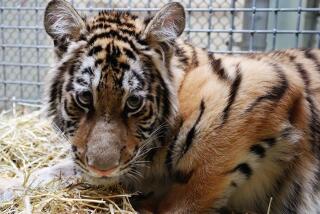Should pandas be saved? Cub’s death could fuel conservation debate
For many, the death of the National Zoo’s newborn panda is a heartbreaking loss. But for others, the cub’s demise could fuel a controversial debate: Is it a waste of time and money to try to save the giant panda, a fragile species already on the brink of extinction?
The question might seem cruel, especially coming just hours after zoo employees discovered that their newest resident, a cub born to giant panda Mei Xiang, had died unexpectedly Sunday morning. But an Oct. 15 meeting at the internationally famed Linnean Society of London was already scheduled on the topic of panda conservation.
The event will take the form of a debate, asking the question, “Do we need pandas? Choosing which species to save.”
QUIZ: How much do you know about pandas?
Among the issues to be discussed by the panel will be whether the millions of dollars spent on time-consuming panda breeding programs have been a wise use of scarce conservation dollars: “Do our conservation efforts focus on large, charismatic species at the expense of many others which may be easier to save?”
There is no debating the appeal of pandas.
Their distinct black-and-white markings, the manner in which they sit upright (like humans), the contented way in which they chomp on leafy bamboo -- such characteristics make them beloved the world over. For their part, zoos scramble for the right to display a panda, because a giant panda is practically guaranteed to draw visitors.
All that roly-poly cuteness belies a solemn reality, however.
The giant panda is an endangered species, and, some fear, on the brink of extinction. It’s the rarest member of the bear family, with only about 1,600 believed to exist in the wild. A few hundred other pandas live in captivity.
The animal’s small numbers are due in part to the fact that panda reproduction can be fraught with dangers, as evidenced by the loss of Mei Xiang’s cub. Some also blame human encroachment on the largely solitary and sensitive creature’s territory.
Today, the panda is the symbol of conservation efforts -- literally. The World Wildlife Fund, one of the world’s most prominent conservation organizations, uses the panda in its logo.
Last week, a World Wildlife Fund representative told the Los Angeles Times that the very notion of allowing the species to go extinct was preposterous.
“Protecting the panda goes beyond basic species conservation,” said Sybille Klenzendorf, managing director of the species conservation program at the World Wildlife Fund. “The panda, which has served as WWF’s logo for more than 50 years, is the universal symbol for hope, so mobilizing people to help protect the panda and panda habitat is representative of protecting and conserving all the rich biodiversity – plants, landscapes, other animals – that are essential to life on Earth.”
Panda-breeding programs have cost millions of dollars and, some say, have produced little to show for it. Breeding experts have tried for years to help Mei Xiang reproduce, for example; she had one other cub seven years ago.
Authorities are still trying to figure out the new cub’s cause of death. The cub made its last recorded sounds at about 9 a.m. Sunday. About 15 minutes later, authorities heard the mother make an unusual sound. Rushing to check on her, they found the lifeless baby.
Emergency efforts to revive the cub failed, and initial autopsy results suggest that the cub’s liver may have been malfunctioning. (There is no evidence that the mother mistakenly crushed the newborn, as can often happen given how small and delicate newborn cubs can be.)
ALSO:
Ft. Hood shooting suspect Nidal Hasan is hospitalized
6 fugitives recaptured after escaping juvenile detention
Airport error: Officer trying to unload gun accidentally fires it
More to Read
Start your day right
Sign up for Essential California for news, features and recommendations from the L.A. Times and beyond in your inbox six days a week.
You may occasionally receive promotional content from the Los Angeles Times.







